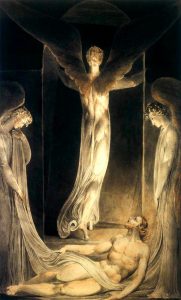[Note: I’m offering the following as a diversion to get our minds off this terrible timeline. –taw]

A few years back, I published a post concerning the date of Jesus’ birth (Why Is Christmas on the 25th of December?), in which we briefly touched on the idea of symmetry between Jesus’ birth and death. I quoted Augustine, who noted the belief, current at the time, that Christ’s conception occurred on March 25.
For He is believed to have been conceived on the 25th of March, upon which day also He suffered; so the womb of the Virgin, in which He was conceived, where no one of mortals was begotten, corresponds to the new grave in which He was buried, wherein was never man laid, neither before nor since. But He was born, according to tradition, upon December the 25th. (Augustine, On the Trinity, Book IV, Chapter 5)
Over time, I’ve become convinced that we can gain more insight into the history of the legends applied to Jesus by examining the symmetry between the incarnation and death legends. Here are a few points to mull over.
- Virgin birth/virgin tomb. Mark (Mk 15:46) merely says that the body was laid in a tomb hewn out of rock. Later evangelists felt compelled to explain that the tomb had never been used. See Mt 27:60, Lk 23:53, Jn 19:41.
- The first Joseph married the virgin (Mt & Lk). The second owned the virgin tomb. Only Matthew insists that it was Joseph of Arimathea’s own tomb.
- The wrapping of the body. Shortly after his birth, Luke (and only Luke) tells us Jesus was wrapped in swaddling clothes and laid in a manger. All four evangelists tell us Joseph wrapped the corpse of Jesus before burial. Mark and Matthew refer to a single cloth that covered his entire body (Mk 15:46, Mt 27:59), while John describes “cloths” (Jn 19:40). Luke, curiously, describes the burial with a single cloth (Lk 23:53), but writes about plural “cloths” after the resurrection (Lk 24:12).
What do you think? What other points of symmetry can you find? Do you think the resurrection legends came first? Or was it the birth legends? Or did they arise simultaneously? Or did they inform one another and evolve over time?
Something else to mull over: Did the later birth-in-a-cave narrative come about because of the earlier rock-hewn-tomb narrative?
Happy Easter, everyone, and keep your distance!
If you enjoyed this post, please consider donating to Vridar. Thanks!

Mary at birth, Mary at the tomb?
Herod sought to kill the infant Jesus; in the Gospel of Peter another Herod crucifies Jesus. (Luke gives the second Herod a cameo appearance in the Passion events.)
I do think the birth and resurrection are related. Resurrection was often seen as a re-birth or second birth. Initiation rituals were considered to be a second birth. The first birth is of the flesh and the second birth is of the spirit.
“There Is Hope for a Tree”: Job’s Hope for the Afterlife in the Light of Egyptian Tree Imagery(Catholic Biblical Quarterly 77, 2015), Christopher Hays
I also suspect this is part of the reason why the women play such an important role in the death/resurrection narrative. I think there may be some ‘remnant’ of the goddess in the women of the Gospel stories. There may also be a connection with “…whom ye slewed and hung on a tree”. Trees(nature in general) being associated with rebirth/resurrection.
There’s also a tradition of deities having two births or a normal birth and then a rebirth/resurrection.
Inter-Actions: Relationships of Religion and Drama(University Press of America, 2009), Nelvin Vos
The Many-Headed Muse: Tradition and Innovation in Late Classical Greek Lyric Poetry(Cambridge University Press,2014), Pauline A. LeVen
Interesting that one birth is celebrated in the winter and the other in the spring.
Jesus was believed to have born in a cave (Dialogue with Trypho, LXXVIII) and reborn in a cave
I think Luke placing Jesus’ birth in a manger among livestock arguably provides foreshadowing of his death, where he replaces/supersedes the Yom Kippur sacrifice. He was born among livestock to be sacrificed as such.